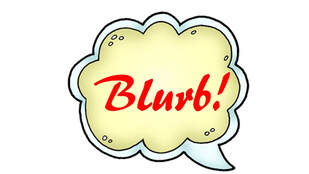 In writers’ groups on social media, authors often post drafts of their blurbs, asking for opinions. It’s a good idea, because it can gain valuable feedback. But in reading these drafts, it is quite obvious that some authors haven’t read any of the numerous blogs that have been written on the subject of blurb writing. In the vast majority of cases, the blurbs won’t sell the book because they fail to capture the interest of the reader within the first few words. Instead, they try to precis the story and what they end up with doesn’t sound interesting enough to sell the book. But experts on blurb writing often say they can write a blurb that will sell a book without even reading the book. And this is a theory we subscribe to, in broad terms, because in the blurb you aren’t telling the story, you are telling the excitement of the story.  You aren't selling the story, you are selling excitement. You aren't selling the story, you are selling excitement. Let’s take visual media (movies, TV and games) and think about how they sell their product. They never try to tell the story. They try to show the viewer/player how much enjoyment they are going to get if they watch the movie or TV show or if they play the game. Depending on the genre, you will get car chases, explosions, gunfights, people falling out of aeroplanes, zombies trying to eat people, people expressing anger, fear or love. If it’s a comedy you will get jokes, either visual or spoken. What’s the most memorable scene in the movie Dumb and Dumber? Yes, that’s right, the one where Harry (Jeff Daniels) has his tongue frozen to the street sign. Yes, that’s in the trailer! By the time a good thirty second trailer is over, people are already setting reminders on their TV, booking seats at the cinema or they are downloading the game. The movie, TV show or game may be the worst ever, but you would never get that from the trailer. Because the trailer looks exciting/horrific/emotional/funny, and the audience wants to see more. The blurb is a book’s trailer, so it has to work the same way.  The reaction many book blurbs get. The reaction many book blurbs get. So many book blurbs just don’t sound entertaining enough. By the end of the first paragraph the reader has already lost interest and is scrolling onto the next book in the search results – somebody else’s book! We try to follow a three paragraph structure for blurbs. If you haven't sold the book by the end of the third paragraph, you probably aren't going to sell it at all. Research has shown, however, that many readers never get past the first paragraph. So that is the crucial one. If that hooks the reader, then the other two paragraphs clinch the sale.  We call this approach (very unoriginally) “hook, line and sinker.” Hook gets the readers’ attention, line reels them in and sinker makes the sale. (Note for the pedants: we know that is not what a sinker does, but we don’t care about that. We just want three simple words to remind us that the blurb comes in three parts. We don’t claim that our fishing metaphor is perfect.)  But the hook is crucial. It does 80% of the work in selling the book, because if it isn’t sharp enough, the reader’s attention will already be moving onto the next book in the search results. A good hook is made up of three parts (do you see a trend emerging here?): character – conflict – consequences. Who is the character, what conflict have they become embroiled in and what are the consequences of failure? But it also has to indicate the book’s genre without wasting words by making it explicit. If you write westerns, you might use the words gunslinger, drifter or cowboy. If you write medical romances, you might mention a doctor or a nurse. These indicate the genre without having to describe the genre. The hook can be written as three sentences, or as a single sentence. That isn’t so important. The important thing is that you have less than fifty words to get those things across in an exciting manner. Yes, 50! So, no room for lots of adjectives. No room for descriptions. No room for sub plots. No room for backstory and definitely no room for “world building”.  It has to be the tightest writing the author has ever done, because, if the reader’s mind starts to wander, they’ll never get them back. Here is an example: “When Private Eye Harry Jones was asked to investigate an errant husband, he had no idea it would nearly get him killed.” So, from that sentence we get genre (crime), we get the main character (Harry Jones) and we get the conflict and the consequences in the single word “killed”. To save you having to count, that was just 22 words. I didn’t need 50 and the reader will either be interested in finding out why a routine investigation nearly got Harry killed, or they won’t. I’m not trying to say that example is perfect, but it is the sort of thing blurb writers aim for as a first attempt. A 3 sentence example might be “A private investigator. An errant husband. A deadly assignment.” We still have the character, but without using his name. We still have the genre. We still have the conflict and the consequences. Some genres lend themselves to that approach better than others. I probably wouldn’t use the 3 sentence structure for a romance (though that doesn’t mean it can’t be used).  The second paragraph, which we call “line”, expands on the first to provide it with context. There are a few rules, mainly “don’ts”. 1. Don’t include other characters, focus on the protagonist (or MC if you prefer). 2. Don’t include sub-plots – stick to the main plot throughout. 3. Don’t get into world building, locations or time periods. If the book is set in a specific time period, use a generic term, eg Regency, medieval etc, or just refer to a century. 4. Don’t include backstory. It loses the focus of the blurb. 5. Do ramp up the conflict and the jeopardy. Continuing from our example hook, above, we might develop the line as follows: “When Harry Jones is asked to find out if a client’s husband is having an affair, it leads him into the seedy world of drugs and prostitution. He stumbles on the daughter of an old friend, enslaved to a drug gang. Desperate to help the girl, Harry takes on the gang's boss to set her free.” We can now clearly see the conflict that Harry has to deal with, without using a lot of unnecessary words. At the same time, we introduce a victim that needs help (the girl) and a villain (the gang's boss).  The sinker. The sinker. All that needs to happen now is for the levels of danger to be ramped up so high that the reader has no choice but to buy the book to find out what happens. That is the job of the “sinker” paragraph: “In order to rescue the trapped girl, Harry fights not only the drug gang, but also his own fears. Old memories return to haunt him, paralysing him with indecision. Can he overcome his past and get to the girl before she is killed, or must he watch his friend’s daughter die? Finishing on a question leaves the reader wanting to know the answer. And to find out the answer, they have to buy the book. Yes, it is manipulation, but all marketing is manipulation of some sort.  Different genres use different types of wording. Romance blurbs use phrases like “torn apart by fate” or “star-crossed lovers” or “mutual dislike”. But whatever wording is used, the blurb has to show that the possibility of an unhappy ending is real, so that the reader will want to know the final outcome. The final message we must give you is that the hero must always have control over their actions. They must never be coerced into involvement. So phrases such as “Harry must fight…” or “Harry has to overcome…” are a no-no because they make it look like Harry has no say in the matter. Instead, phrases such as “Harry fights …” or “Harry overcomes…” take out the element of coercion and leave Harry as a hero.  This is because heroes do the right thing because it is the right thing to do, not because they have been made to do it by some outside agency. This is a pretty safe rule when writing a novel anyway. The hero is the hero because they don’t walk away, even though they could. It's is a tough thing to do with some professions. Police, military, firefighters etc have to obey orders, so what we are talking about in a blurb has to be the character going above and beyond the call of duty. Yes it’s the cop’s job to catch the killer, but it isn’t their job to dangle from a ledge a hundred feet up while they do it.  Here’s a free offer for you. If you want to try out your ideas for your blurb, email it across to us at the address on our “contacts” page, we’d be happy to provide you with a bit of feedback, free of charge. Of course, if you’d like to browse our books catalogue while you’re waiting, we’d be delighted. You’ll find some stuff to read on our “free stuff” page. Pull up a seat, pour yourself a cup of coffee and we’ll get back to you as quickly as we can. If you have enjoyed this blog, or found it informative, then make sure you don’t miss future editions. Just click on the button below to sign up for our newsletter. We’ll even send you a free ebook for doing so.
0 Comments
Leave a Reply. |
AuthorThis blog is compiled and curated by the Selfishgenie publishing team. Archives
June 2025
|
 RSS Feed
RSS Feed